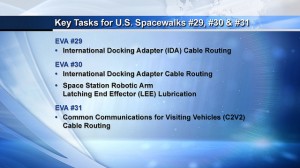Breathe in …the Airway Monitoring Experiment.
I remember clearly the long discussions we had when I worked as a lifeguard many years ago: should we give heart patients in need “nitroglycerine spray”? On the one hand, the nitro spray can provide fast relief to people suffering from heart conditions – on the other hand it can quickly drop a patient’s blood pressure, which should be avoided at all costs in an emergency. We decided against it – and we took the right decision.
A nitroglycerin spray acts on nitric oxide which is produced by the human body itself and is a good indicator of airway inflammation: a higher amount of nitric oxide in exhaled air indicates an inflammation. How this works exactly and how air pressure and gravity-influenced blood flow can affect readings were researched in the complex “Airway Monitoring” experiment last Friday on the Space Station.
The results are important for basic medical research and for future manned missions to other celestial bodies. Moon and Mars dust is very aggressive so not only do mechanical parts that are exposed need to be prepared, experts are also having headaches about how to protect the human respiratory tract. Inevitably dust will collect in air locks and spacesuits in the air of lunar or Mars stations. In these cases it will be important to get early signs of airway inflammation…
ESA astronaut Samantha Cristoforetti and NASA astronaut Terry Virts had begun preparations for the experiment on Thursday. They brought the equipment into the Quest airlock, which is usually used as a door to the outside of the International Space Station. Barry Wilmore as Crew Medical Officer was also briefed to standby his colleagues during the experiment.
On Friday, the experiment started with Samantha and Terry started to reduce the pressure in the American airlock. The complicated procedures for this were developed through international teamwork. The expertise of the Danish DAMEC Center worked with flight surgeons, the team in Houston that controls the airlock, and us at Oberpfaffenhofen. At the Columbus Control Centre Katja Leuoth and Marius Bach supported the astronauts from the control room. This support was important as the astronauts needed support for such a complex experiment. The ground team found solutions in real-time for some questions, others needed more in-depth study and analysis. Now it is over to the scientists: the data must be processed and evaluated – and a decision must be made to continue with more experiment runs. The Columbus Control Centre will be ready to put the astronauts back in the airlock to answer their questions and pave the way for future missions landing in “thin air”…
Col-CC
More information here: https://plus.google.com/+SamanthaCristoforetti/posts/MtNoDoiRMfZ https://plus.google.com/+SamanthaCristoforetti/posts/boWGMq3mPgX https://www.esa.int/spaceinimages/Images/2015/03/Samantha_working_on_Airway_Monitoring
13/03/2015





